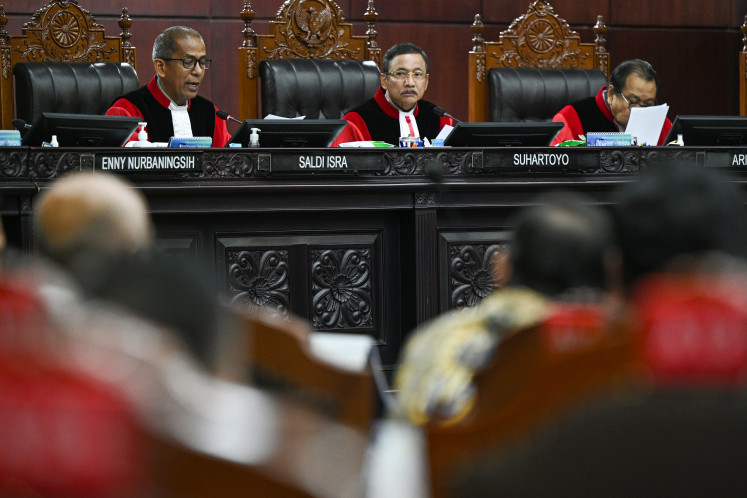Popular Reads
Top Results
Can't find what you're looking for?
View all search resultsPopular Reads
Top Results
Can't find what you're looking for?
View all search resultsLessons from the Jews and conflict resolution
The historical backdrop of the Israel-Palestine conflict can be traced back 5,000 years to 3000 BC
Change text size
Gift Premium Articles
to Anyone
The historical backdrop of the Israel-Palestine conflict can be traced back 5,000 years to 3000 BC.
The story of struggling Jews is part legend, part scriptural, part psychological, and entirely political.
Religions happens to be in the picture because the Middle East is the birthplace of three monotheisms — Judaism, Christianity and Islam — thus making it “the cradle of civilization”.
This “cradle” status ensures the region is continuously in the limelight. Religions are involved, yet they are not the main concern. Instead, this conflict is a humanitarian issue of massive proportion. Like the Mindanao conflict, the Israel-Palestine conflict also centers on a piece of land.
The notion that Jews are highly regarded because of the notion of the “the chosen” people is not a valid argument, to begin with. A religious belief, after all, is simply a belief.
Many things can be learned from the Jewish Diaspora, which started 3,700 years ago. Contrary to popular belief, such Diaspora was not induced by the Romans in 70 CE.
The story of this people is more of betrayals and preservation of culture, something we all should
acknowledge and be aware of.
The politics of the Jewish Diaspora, however, has resulted in a tremendous amount of casualties over the centuries, including Jews and Arabs. Thus, it would not be fair to point fingers, as both might feel that they have been unfairly treated.
Muslims and Jews were close brothers until the incident in Medina when Jewish influences were eliminated for not accepting Islam. It is distinguishable that a religion is both a spiritual vehicle and a political instrument. When it is used as a political instrument, the scripture is likely to show such an inclination.
Now fast forward. The birth of Zionism, which was a movement of renewal for Jews by Theodore Herzl is meant to be the antithesis of antisemitism, which started a whole new ball game that continues to this very day. With the 1917 Balfour Declaration, in which the United Kingdom officially recognized the Jewish people’s right to a homeland in Israel, and Woodrow Wilson’s notion of self-determination, the dream of unity provoked the Pan-Arabism movement, which created more antisemitism.
During that period, the Turks, then the Ottoman Empire, loosened up immigration regulations, which resulted in waves of Jewish migration to Palestine. Such influxes brought some level of prosperity to Palestinian Arabs who sold their lands to the highest bidders, and eventually better healthcare and longer life expectancy. Yet some Palestinian Arabs saw the Jews as a threat to their sovereignty due to UK and US influences. Since then, widespread riots have been used as instruments of revolt.
The UK and US have been involved in the region in rounds of talks. Harry Truman supported Zionists due to the promise of the Balfour Declaration and belief in humanity to compensate holocaust survivors.
In 1947, the UN General Assembly declared the division of Palestine into a Jewish and an Arab state.
Minority Jews the Irgun and the Lehi did not accept the partition. Soon after, both Jews and Arabs evacuated due to ensuing wars. Then there was war over Suez, the capture of Gaza, and Eisenhower’s opposition against Britain’s, France’s and Israel’s resistance against Egypt.
In 1964, the Palestine Covenant was drafted. It redefined who “Palestinians” were and declared Zionism a political movement bred for imperialism and fascist in nature. It also nullified the partitioning of Palestine in 1947. Next, UN Security Council Resolution No. 242 was rejected by PLO for failing to mention that “all” would withdraw from occupied territories. Attacks and wars followed with the US and the Soviet Union on one side and Egypt-Syria-Lybia-Sudan-Algeria-Moro-cco on the other side. An oil embargo to the US ensued.
A subsequent breakthrough attributed to Jimmy Carter was a catalyst resulting in the Camp David Accords on Sept. 17, 1978. Still, rounds of peace, war, and ceasefires occurred with the rise of the terrorist armies of Palestine, until now.
The recent raid on the “Freedom Flotilla”, resulting in nine deaths, diffused hopes for peace and severed Israel’s relationship with Turkey. Israeli said they were protecting themselves against terrorism including in open waters. San Remo Manual on International Law Applicable to Armed Conflicts at Sea Clause 67 was used in the argument. This argument was not valid, as Hamas is not a state and the vessel’s flag was Turkish. With international laws now more normative than “actual” laws, new rounds of creative conflict resolution are expected.
Johan Galtung, a mathematician and a sociologist, and the father of peace and conflict studies, proposed a six-state solution using Transcend’s “creative formula”, in which he focused on equal rights of the parties in conflict. The six equal states he proposed are: Israel, Palestine, Egypt, Jordan, Lebanon, and Syria as full members.
At last, remember to use a “peace” approach, in every conflict situation, not merely a “security” approach. The former focuses on resolving and transforming conflicts, while the latter focuses on punishment.
The writer (www.jenniesbev.com) is an author and columnist based in Northern California.










